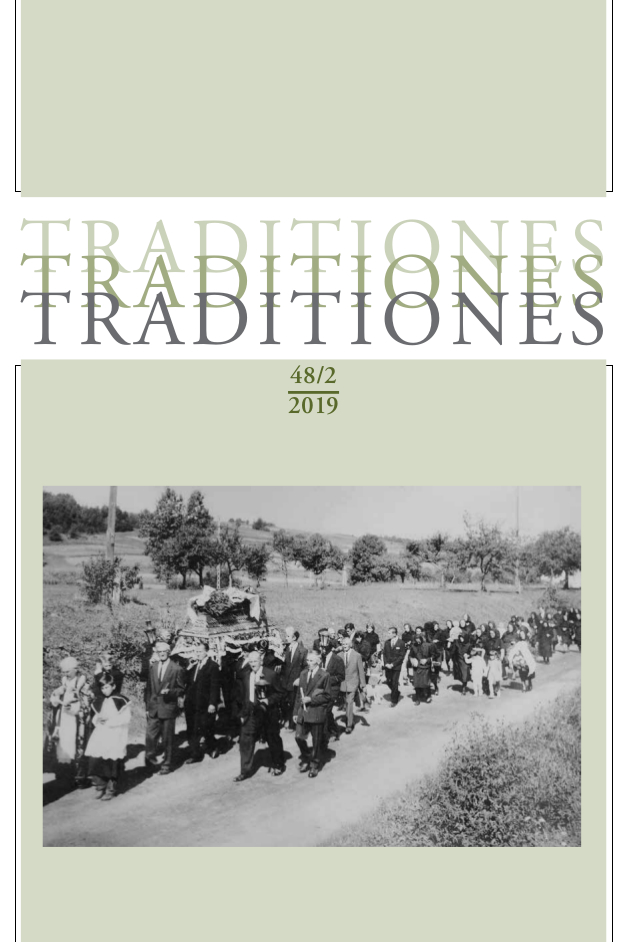Organ Accompaniment Practices of Uneducated Cantors in Small Villages of the Carpathian Basin
DOI:
https://doi.org/10.3986/Traditio2019480207Keywords:
peasant cantors, organ accompaniment, harmonization, Carpathian Basin, East-Central Europe, music, tradition, church music practiceAbstract
Cantors uneducated in music are usually outside the church hierarchy, but inside the community in small Christian villages of east-central Europe. Their organ playing and accompaniment may preserve characteristics from previous centuries and can be regarded as proof of a formerly widespread harmonization method, but may also appear within music learning as a certain degree of musical knowledge, offering an anthropological explanation of the entire phenomenon. Using the inductive method, the results of case studies from the Carpathian Basin can be considered more or less valid for the larger European region (i.e., east-central Europe) with similar history, social development, and cultural circumstances.
Downloads
References
Diamandi, Saviana, and Ágnes Papp (eds.). 1993/94. Codex Caioni saeculi XVII = Musicalia Danubiana 14a, b. Bucharest: Muzicală a Uniunii Compozitorilor şi Muzicologilor din România. Budapest: MTA Zenetudományi Intézet.
Eder, Petrus OSB. 2004. Die modernen Tonarten und die phrygische Kadenz. Tutzing: Hans Schneider (Tübinger Beiträge zur Musikwissenschaft; 26).
Fekete, Antal. 2009. Csiszár Aladár és péterlaki zenekara. Fekete Antal gyűjtéseiből 10 [Aladár Csiszár and His Band from Péterlaka. From the collections of Antal Fekete]. (= FECD 042). Budapest: Folk Európa.
Fellerer, Karl Gustav. 1982. Zur Kirchenmusik Roms im 17. Jahrhundert. In: R. Goerner, Logos Musicae: Festschrift für Albert Palm. Wiesbaden: F. Steiner, 71–82.
Ferenczi, Ilona, and Marta Hulková (eds.). 1986. Tabulatura Vietoris saeculi XVII. Bratislava: Opus (Musicalia Danubiana 5).
Flotzinger, Rudolf. 1976. Die kirchliche Monodie um die Wende des 16./17. Jahrhunderts. In: Karl Gustav Fellerer (ed.), Geschichte der katolischen Kirchenmusik 2. Vom Tridentinum bis zur Gegenwart. Kassel: Bärenreiter, 78–87.
Kodály, Zoltán. 1933. Néprajz és zenetörténet [Folklore and Music History]. In: Ferenc Bónis (ed.), Visszatekintés II. Budapest: Zeneműkiadó Vállalat, 225–234.
Massenkeil, Günther. 1976. Die konzertierende Kirchenmusik. In: Karl Gustav Fellerer (ed.), Geschichte der katolischen Kirchenmusik 2. Vom Tridentinum bis zur Gegenwart. Kassel: Bärenreiter, 92–107.
Pávai, István. 2012. Az erdélyi magyar népi tánczene [Hungarian Folk Dance Music in Transylvania]. Cluj (Kolozsvár): Kriza János Néprajzi Társaság.
Richter, Pál. 1999. Kvint- és oktávpárhuzamok a 17. századi orgonakíséretes kéziratokban [Consecutive fifth and octaves in 17th-century manuscripts with organ accompaniments]. In: Ágnes Gupcsó (ed.), Zenetudományi Dolgozatok. Budapest: MTA Zenetudományi Intézet, 239–256.
Richter, Pál. 2001. Quint- und Oktavparallelen in den Handschriften mit Orgelbegleitung des 17. Jahrhunderts. Ars Organi 49: 19–26.
Richter, Pál (ed.). 2005. Kájoni János: Organo=Missale. Csíkszereda: Státus Könyvkiadó (A Csíksomlyói Ferences Könyvtár Kincsei 3).
Richter, Pál. 2006. Napja Isten haragjának. Egy temetési ének írásos emlékei és néphagyományban élő változatai [The Day of God’s ire. Written and oral versions of a funeral song]. Magyar Zene 44 (3): 263–277.
Richter, Pál. 2013. From the Harmonies Used in Folk Music to the Harmonization of Folk Song Arrangements. In: Jozef Vereš & Martina Moravshik (eds.), Hudba – Integrácie – Interpretácie 16 / Music—Integration—Interpretation 16. Nitra: Univerzita Konštantína Filozofa v Nitre, 109–148.
Szabó, Csaba. 1977. A szászcsávási többszólamúság [The Szászcsávás polyphony]. In: Csaba Szabó (ed.), Zenetudományi írások. Bucharest: Kriterion, 109–123.
Szabó, Csaba. 2001. Erdélyi magyar harmóniás énekek a XVIII. századból [The 18th-Century Hungarian Practice of Vocal Harmony from Transylvania]. Budapest: Balassi Kiadó. CD-ROM.
Szabolcsi, Bence. 1955. A magyar zenetörténet kézikönyve [Handbook of Hungarian Music History]. Budapest: Zeneműkiadó Vállalat.
Szigeti, Kilián. 1967. A szombathelyi egyházmegye egyházi zenéjének története [The history of the church music of the Szombathely diocese]. In: Imre Tóth (ed.), A 200 éves szombathelyi egyházmegye emlékkönyve [The memorial book of the 200 years-old Szombathely diocese]. Szombathely: Szombathelyi Egyházmegyei Hatóság, 243–430.
Downloads
Published
How to Cite
Issue
Section
License
Authors guarantee that the work is their own original creation and does not infringe any statutory or common-law copyright or any proprietary right of any third party. In case of claims by third parties, authors commit their self to defend the interests of the publisher, and shall cover any potential costs.
More in: Submission chapter






